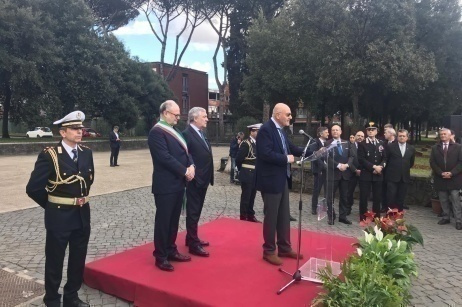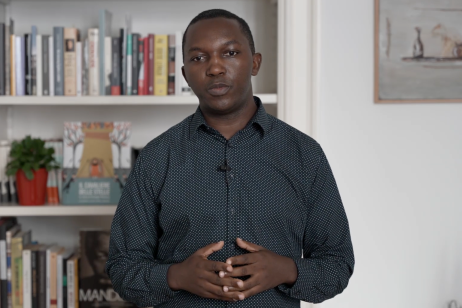On the same day that I read Gariwo’s theme for this year’s Day of the Righteous would be “Saving the Humanity in Humankind. The Righteous and personal responsibility,” a disturbing story was circulating through the American news. Before I can explain why that particular news story gave extra urgency to Gariwo’s theme, I must first explain why I think Gariwo’s avoidance of painting gardens in any specific “political coloring”1 (i.e., endorsing any particular political ideology) is so important. That viewpoint comes from my nearly 40 years of experience as a teacher.
When I taught my first cultural anthropology course at an American university in 1983, I was concerned about how to fulfill the requirement of promoting “politically correct” ideology. I understood the political ideology I was supposed to promote (i.e., I knew what political color the university wanted me to use). However, I was uncomfortable advocating for any political ideology because I couldn’t present myself as a morally superior expert. For me, cultural anthropology’s goal was to increase knowledge by testing hypotheses. For that to occur, it was necessary to distinguish hypotheses about how the world was from statements about how it should be. I felt to do otherwise was to become, in the words of Gabriele Nissim, an “omnipotent bringer of an absolute truth.”2 I refused to take on such a role because I couldn’t think of anything in my academic experiences that qualified me as morally superior to anyone.
Fortunately, I came up with a plan that would appear to meet the course requirements without requiring me to pretend to know more about right and wrong than my students. First, I asked the students if they agreed that there were some problems between categories of people in our country and in the world. Then, since students always agreed with that premise, I said I wanted to learn what they, the students, thought were the best solutions. Halfway through the first course, the students’ solutions formed a typology that would reappear in many of the 300 subsequent classes I taught. The typology became a part of my courses known as the “types of solutions to us/them problems” discussions.
By chance, the first solution to problems between us/them groups put forth by a student was to eradicate group identities and treat everyone as an individual. Thus, that solution became “solution #1,” although it did not end up being the most popular solution at the end of the course. The second solution offered by a student was to keep group identities but treat all groups equally. It became known as “solution #2.” The solution designated “solution #3” was to treat disadvantaged groups better than other groups in order to make up for past maltreatment. That third solution was the “politically correct” position that I was supposed to teach the students to support. Although the details of discussions in each course varied, discussions nearly always included the following points and counterpoints.
Students favoring the first solution often emphasized Martin Luther King’s dream of his children one day being judged on the quality of their character instead of the color of their skin. However, even some students who liked the individual solution said it wasn’t possible because people can’t avoid placing labels on categories of people. Many students agreed with that counterargument, but some also pointed out that humans were experts at expanding, contracting, or adjusting the categories they used to fit their current goals. Therefore, one version of solution #1 favored by some students was to emphasize the United States of America category but treat all Americans as individuals by de-emphasizing any internal sub-divisions within that category.
Students favoring the second solution of treating all groups equally equated that position with standard conceptions of equal rights and employment opportunities regardless of which group a person belonged. They often defined their solution in terms of their opposition to “affirmative action.”
In contrast, students favoring the third solution of treating some groups better than others favored “affirmative action.” They argued that past inequalities between groups had led to current disparities. Preventing any further change merely solidified those disparities and guaranteed that they would persist into the future.
Some students would also point out that there was a fourth solution to problems between groups of people: groups could separate from each other. However, only one student ever stated their preference for that position.
The topic of genocide emerged during most courses. Proponents of treating everyone as individuals often argued that treating people as members of groups (i.e., identity politics) was what made genocide possible. Thus, eliminating group labels would prevent one group from committing genocide against another. In contrast, other students argued that treating disadvantaged and oppressed groups better than other groups was the only way to prevent the previously underprivileged groups from becoming the victims of genocide. Other students countered that position by arguing that a continued pattern of unequal treatment to offset previous unequal treatment would lead to a chain reaction of revenge genocides.
When I introduced the topic of the Righteous, some students saw the Righteous as an example of solutions #2 or #3. Those students saw the act of saving potential victims of genocide as a clear example of treating members of oppressed groups as well as, or even better than, members of other groups. Other students argued that the Righteous saved potential victims because they saw them as individuals instead of group members. That explanation made the Righteous an example of solution #1.
Throughout each semester, I assigned readings supporting each of the three solutions, encouraged students to relate their views to those readings, and promoted an environment conducive to speaking one’s opinions. Near the end of the course, I would also bring up any arguments put forth by students in earlier classes if they had not come up on their own.
I only had three goals for the discussions. The first goal was to have as many students as possible think about their positions (as I hope you have been doing) and be willing and able to state the reasons for those positions. I also started each semester hoping that at least a few students would favor each alternative solution, and classes always met that goal. My third goal was to minimize the influence of my views on the students’ views. Fortunately, students rarely asked what solution I favored. When students did ask, it was near the end of the course, and I always had them guess before I answered the question. The guesses were always nearly evenly distributed between the three optios, and I considered that evidence of some success in attaining my goal. Then I always said I preferred to treat everyone within the category of humans as individuals. Finally, I reminded students not to put any more weight on my opinion than anyone else’s.
Although students inevitably divided themselves into supporters of one of the three solutions, the relative proportion supporting each position changed noticeably from semester to semester. Sometimes the change had no discernable cause, but other times it did. For example, the only semester where one position ended up being favored by an absolute majority of students was the one that started with the 9/11 attacks on the United States. That semester, most students favored emphasizing the category of “Americans” and de-emphasizing categories within America. In contrast, when protests surrounding police brutality toward certain groups became prominent in 2014, the plurality of students supported treating some groups within the United States better than other groups to offset past disadvantages and create an equitable world. I considered all those outcomes equally successful because they all involved students thinking, debating, and learning from each other before choosing a position.
The 21st century brought a change to the terminology used to describe solution #3, as “woke” replaced “politically correct.” Unfortunately, in terms of my teaching goals, the new vocabulary brought with it a far more important change. As soon as students realized that they would be allowed, and even encouraged, to argue in favor of any of the alternative types of solution, some students objected. Those students called a discussion of alternative solutions “problematic.” Thus, my teaching methodology was essentially “canceled.” By 2017, I had to choose between retiring or “teaching” the unquestioned acceptance of the officially sanctioned solution to us/them problems. I chose retirement.
The change in academia to teaching only one official solution is unfortunate if you agree with Gariwo that personal responsibility is necessary to prevent genocide. A sense of personal responsibility for a political policy is the product of one’s freedom to learn, debate, and freely choose that policy. When education requires the acceptance of an officially endorsed policy, one no longer feels personally responsible for the consequences of that policy.
I am writing this essay now because the news surrounding the story mentioned at the beginning of this essay described how the forced acceptance of one solution to us/them problems will no longer be restricted to college classrooms. Instead, if successful, the powers of the United States’ federal government will enforce the acceptance of specific solutions in many aspects of social life.3 If that wasn’t enough of a threat to the humanity of humankind, much of the subsequent discussion about the news story focused on how technology like facial recognition and artificial intelligence could enforce the officially approved solution to us/them problems. At that point, humanity really will have been removed from humankind.
1, 2 Nissim, Gabriele. “Il messaggio dei Giusti”
https://en.gariwo.net/editorials/the-message-of-the-righteous-19678.html
3 Executive order entitled “Further Advancing Racial Equity and Support for Underserved Communities Through the Federal Government” https://www.whitehouse.gov/briefing-room/presidential-actions/2021/01/20/executive-order-advancing-racial-equity-and-support-for-underserved-communities-through-the-federal-government/








